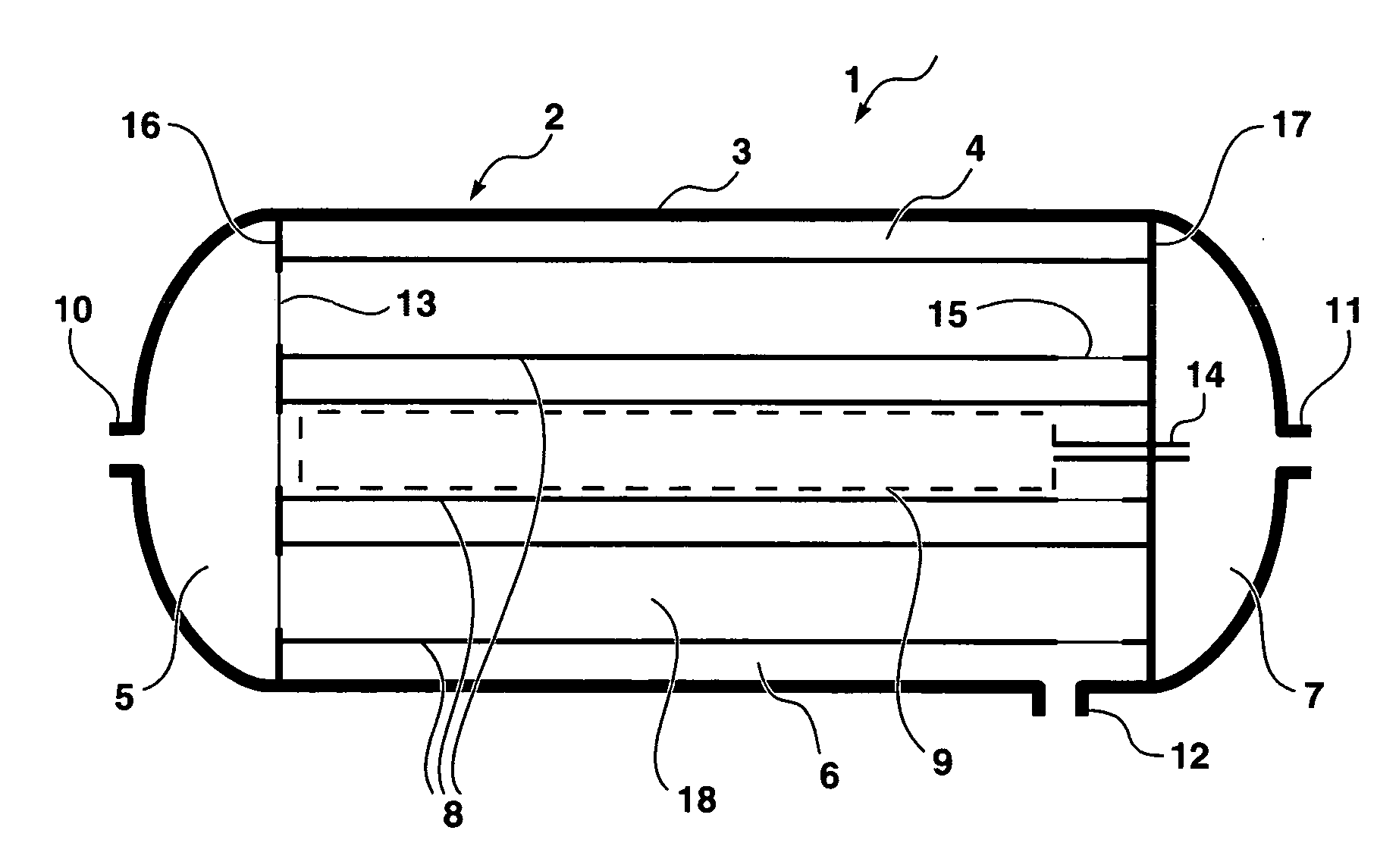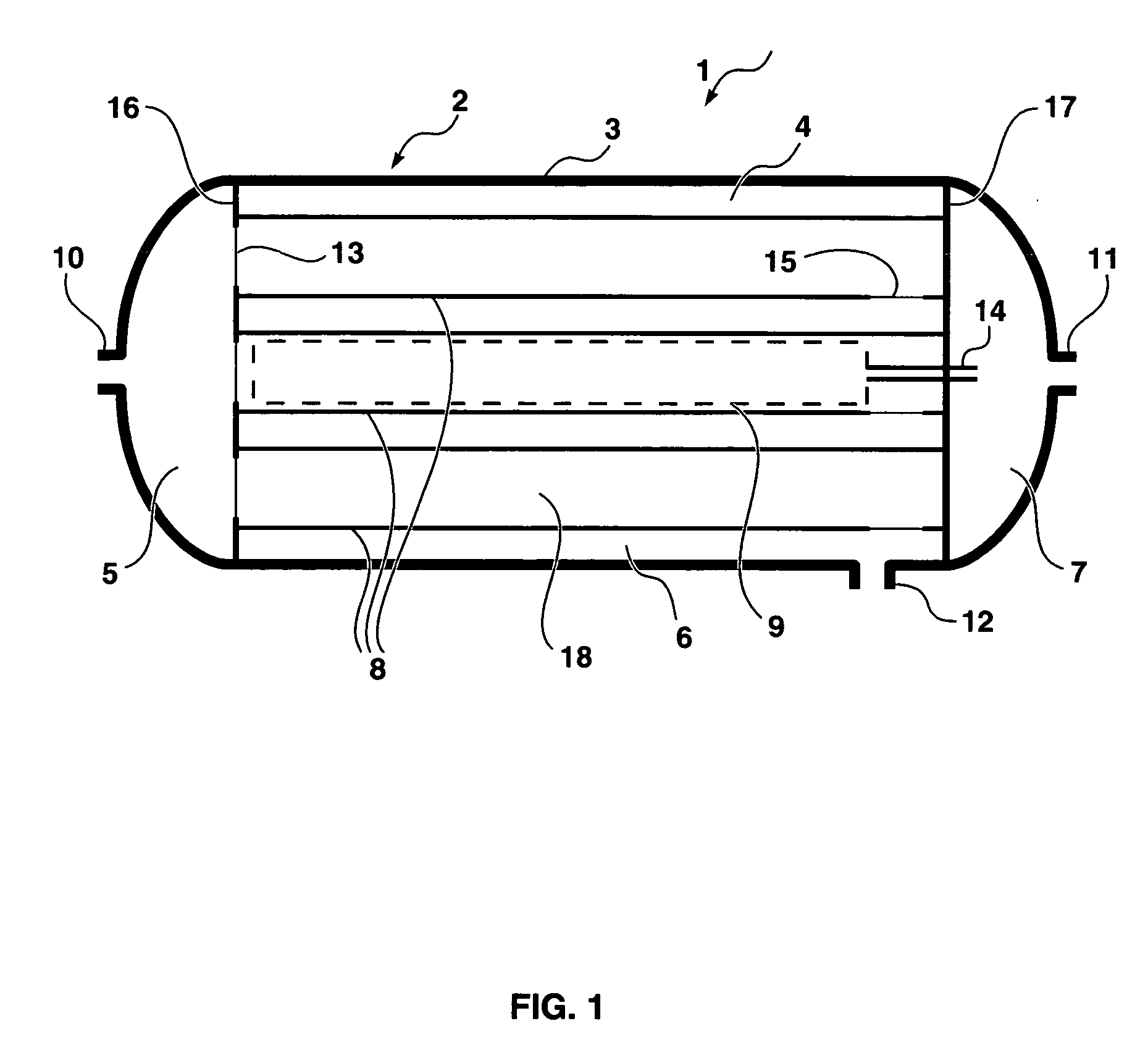Gas separation membrane module assembly
a technology of gas separation membrane and module, which is applied in the direction of membranes, filtration separation, separation processes, etc., can solve the problems of limited operating li
- Summary
- Abstract
- Description
- Claims
- Application Information
AI Technical Summary
Benefits of technology
Problems solved by technology
Method used
Image
Examples
example 1
Comparison of Skid Size Requirements for Gas Separation System Using Conventional Pressure Tubes, Seven-Tube Vessels and 19-Tube Vessels
[0164]An approximate comparison was made of the skid size that is needed to provide sufficient membrane capacity for a system constructed using prior art pressure tubes or the multi-tube pressure vessels of the invention.
[0165]FIG. 8 illustrates the difference in footprint requirements for a gas-separation system using a conventional pressure vessel, a seven-tube vessel and a 19-tube vessel. The system was assumed to need about 4,500 to 5,000 m2 of membrane area in the form of spiral-wound modules and to be operating at a feed pressure of about 500 psi. In each case, the membrane modules are arranged in an end-to-end series of 4 modules inside a tube, and the length of the skid is about 23 feet. The difference in size is evident in the different widths.
[0166]FIG. 8 (a) shows a conventional configuration, not in accordance with the invention. The tub...
example 2
Complexity Comparison of Conventional Pressure Tube, 7-Tube Vessel and 19-Tube Vessel Skid Configurations
[0170]Table 1 compares some properties of standard skid configurations containing roughly comparable membrane area as illustrated in FIG. 8. Using the number of connection features (such as flanges) and tubes as one measure of complexity, it can be seen that seven- or 19-tube pressure vessels greatly decrease the complexity of the skid configuration.
[0171]
TABLE 1TotalTotalTotalNumberVesselsVes-footprintmembraneTotalVessel Typeof skidsper skidsels(ft2)area (m2)FlangesConventional88641,1205,120192 7-tube2483404,4802419-tube332504,5609
example 3
Comparison of Vessel Diameters for Pressure Vessels Containing Seven Tubes
[0172]A calculation was performed to compare the pressure vessel diameter needed to house seven tubes according to the arrangements shown in FIGS. 5 and 6. Both drawings are cross-sectional schematics showing the face of a tube sheet in a pressure vessel operating at about 700 psi. For both embodiments, the tubes within the pressure vessel are 8 inches in diameter. The schematics in FIGS. 5 and 6 show that it takes three tubes to span to the diameter of the pressure vessel. A tolerance of one quarter to one eighth inch is allowed for the end-plate diameters.
[0173]FIG. 5 shows a tube sheet at the permeate end of a pressure vessel For the embodiment as shown in FIG. 5, the tube sheet, 52, has openings that are eight inches in diameter, 54, and end plates, 53, that are 13 inches in diameter. The openings are large enough to allow tubes to pass through the tube sheet.
[0174]For the embodiment shown in FIG. 6, the t...
PUM
| Property | Measurement | Unit |
|---|---|---|
| area | aaaaa | aaaaa |
| area | aaaaa | aaaaa |
| weight | aaaaa | aaaaa |
Abstract
Description
Claims
Application Information
 Login to View More
Login to View More - R&D
- Intellectual Property
- Life Sciences
- Materials
- Tech Scout
- Unparalleled Data Quality
- Higher Quality Content
- 60% Fewer Hallucinations
Browse by: Latest US Patents, China's latest patents, Technical Efficacy Thesaurus, Application Domain, Technology Topic, Popular Technical Reports.
© 2025 PatSnap. All rights reserved.Legal|Privacy policy|Modern Slavery Act Transparency Statement|Sitemap|About US| Contact US: help@patsnap.com



